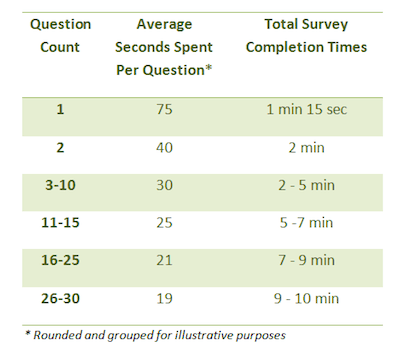Why Ask for Open-Ended Feedback in Surveys?

Last updated on November 14, 2023
In this article, we’ll discuss the challenges of low response rates on surveys and why companies should consider asking just one open-ended question for feedback instead.
Open-ended feedback allows for more authentic responses and avoids survey bias. However, managing open-ended feedback in a scalable and structured manner can be difficult.
To solve this issue, companies can use AI-powered text analytics software to process and analyze customer feedback, giving more consistent and real-time results. By keeping surveys simple and using AI-powered text analytics, companies can gather valuable insights about their customers and improve their overall customer experience.

In This Article:
The first question you might be asking is, why are you having low response rates? Low response rates on surveys are a common problem faced by many companies. While collecting a lot of information from customers can be valuable, long surveys often lead to low participation and unreliable data.
To overcome this issue, companies can consider including one open-ended question for feedback instead. This approach not only saves time for customers, but also ensures that the data collected is of better quality and reliability.
According to SurveyMonkey, the longer the survey, the less time respondents spend answering each question, hence affecting the accuracy of the data. By asking just one open-ended question, companies can still gather valuable insights about their customers and avoid the pitfalls of long surveys.

Source: SurveyMonkey
Usually what happens in this scenario is that the respondent rushes through the questions, giving super short answers without any real thought or detail included. You are left without any actionable insights.
Depending on your business, level of resources, and the ambition that you have with regards to surveying your customers, it could be smarter to just give them the chance to leave some open-ended feedback. Skip all the fuss, and just get straight to the point!
To learn more about best practices for collecting customer feedback, check out this article: How to collect customer feedback
Why ask for open-ended feedback and why some don’t like it
When you ask for open-ended feedback, what usually happens is that your respondents comment on what they experienced to be the most critical things in the interaction they just had with your company. According to Survicate, open-ended feedback allows you to get more authentic responses where you get to know what your customers really think about you.
Think about it, if you encountered an exceptionally bad customer service representative, this would probably be the first thing you would comment on if you were given the chance to leave open-ended feedback. In some cases customers will write the equivalent of a short novel, sharing in great detail what was good and what was not so good. Responses like this yield really rich insights for companies that aspire to greatness!
Another important thing to consider when deciding between open-ended feedback and long surveys with lots of specific questions is bias.
If you have a survey with 200 questions (a bit overboard, but you get the point!), you practically give your customers a guided tour of the kind of answers you would like them to give you. Some companies add the chance to leave open-ended feedback after the 200 questions, at which point the customer has already forgotten about the most important thing they wanted to comment on in the first place. In cases like this, it is not uncommon to get an angry comment saying; “survey far too long, don’t ask me for feedback again”.
The simplicity of asking just “tell us what you think” can be so much better. Then you really get to know what customers think and talk about, and what is most important to them.
What can be challenging with open-ended feedback, however, is processing the feedback in a scalable manner and ensuring that all valuable insights are realized. Open-ended feedback for many can be viewed as a great unstructured mess. It is often seen as way too difficult to manually structure the data, even with the promise of those golden nuggets of insight at the end!
Tips for Writing Effective Open-Ended Questions
If you’re looking to get the most out of open-ended feedback surveys, it’s important to craft effective open-ended questions. Here are some tips for writing open-ended survey questions that provide meaningful insights:
1. Use Actionable Language – Ask open-ended questions that allow customers to provide detailed responses about their experiences. Avoid using open-ended questions that could easily be answered with yes/no or multiple-choice answers.
2. Keep Questions Open to Interpretation – Make sure open-ended survey questions are framed in a way that allows for different interpretations and opinions. This will enable you to get more detailed and varied responses from customers.
3. Ask Open-Ended Follow Up Questions – Depending on the open-ended survey questions you’re asking, it may be helpful to follow up with open-ended questions that allow customers to elaborate further.
4. Balance Open-Ended Questions With Multiple Choice – Don’t forget to include multiple choice and yes/no survey questions in your open-ended feedback surveys. This will help to limit open-ended responses and enable you to better analyze and compare customer sentiment.
By following these tips, open-ended survey questions can be an invaluable tool for gathering valuable insights about customer satisfaction and overall sentiment. With open-ended feedback surveys, businesses can accurately assess sentiment and identify areas of improvement in order to better serve their customers.
How to manage open-ended feedback in a scalable and structured manner
There is a simple way to retrieve customer insights and structure the data you receive from open-ended feedback, and that is to analyze it with AI-powered text analytics software made for customer experience management. The advantages of using text analytics are many- including scalability, real-time analytics, and consistent criteria.
Scalability means that it allows businesses to structure a large amount of feedback in seconds, rather than days (sometimes even weeks or months), and you can use it to structure text from different data sources, such as email, social media, chats and so on.
Text analytics enables you to get your results in real time. Having a delay between a customer’s negative experience and you taking action to resolve the problem can often mean that you lose a customer and create a brand detractor. Text analytics makes it possible to act on and resolve negative feedback as soon as it arises.
Another great about using AI-powered text analytics is that you can reduce the number of human errors. Manually analyzing a large amount of text is not fun, and it takes a lot of time. Since the process itself is so monotonous, the risk of making errors is really high.
As humans, we are also influenced by personal experiences and beliefs that can affect the manual analytics process and give biased results, leading to the wrong conclusions. AI-powered text analytics, trained to identify specific categories or topics for your industry, will definitely give you more consistent results.
You can harness the power of AI and let it process and analyze your customer responses, calling out the positive and negative things that people are saying about your brand, product or service. AI can categorize your feedback and help you to answer a key question- “What are my customers talking about?”
Wrapping it all together
It makes sense to avoid making surveying too complex – especially if you don’t have the resources to manage all the responses to your 100+ questions! And be honest, are all these questions really that important? Probably not. The only result you’ll get is a frustrated customer and a pile of responses that you cannot structure or retrieve any insights from. Keep it simple- ask for open-ended feedback and use an AI-powered text analytics service.
